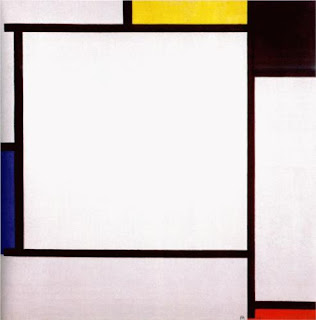Piet Mondrian started out doing paintings that were "representational" which means the painting looks like something in the real world. But over time he started to paint in a different way called "abstraction" which means something doesn't need to look like something the real world.
Lots of times artists start out painting one way, and over time they start painting different ways. Sometimes they do it because they like trying new things. For Mondrian he had a way of thinking about art where he believed paintings didn't need to look like things in the real world. The way he painted changed to match what he was thinking.
These 2 paintings show how Mondrian started painting. They are of a farm, and a sunflower. When you look at them, you can tell what they are.
Small farm on Nistelrode, 1904
A painting of a sunflower - 1907
This painting of a a mill starts to show how Mondrian was starting to make his paintings not look like things in real life.
The Red Mill - 1910
And this one shows how he started using the squares, lines, and only a couple colors in one painting.
Composition in Color A - 1917
Later, Mondrian's style turned into using black lines and the colors red, yellow, and blue. They don't look like anything in real life, but they are still neat to look at. You could even make up a story about them if you wanted to.

Composition with red, blue, and yellow-1930
Composition 2-1922
Composition C - Number 3-with red, yellow, and blue-1935
Composition A -1923
Broadway Boogie Woogie-1943
Piet Mondrian
Born: 07 March 1872; Amersfoort, Netherlands
Died:
01 February 1944; New York, United States
Nationality:
Dutch


Self Portrait (1900) and a picture of what Piet Mondrian looked like
- His style was precise, using geometric shapes in mostly the primary colors of yellow, blue, and red
- It was a style that Mondrian called "neoplasticism" ("nieuwe beelding" in Dutch).
- Mondrian's paintings did not sell very well during his lifetime.
- Mondrian had his first one-man show when he was 70 years at the Valentin Dudensing Gallery in New York City
- 1892 - 1897 - Mondrian studied art at the Rijksakademie van Beeldende Kunsten (Amsterdam Academy of Fine Arts) where he painted mostly landscapes
- 1912 - He moved to Paris, France, but during World War 1, he moved back to the Netherlands.
- 1917 - Mondrian and Theo van Doesburg started a very influential art magazine called "De Stijl," which means "The Style."
- 1919 - Mondrian returned to Paris. And he stayed until 1938.
- 1938 - He moved to London, England, where he painted for 2 years.
- 1940 - He moved to New York, USA, where he spent the final four years of his life.
- Mondrian moved to a new studio where he would BIG pieces of paper up on the wall that he'd move around different ways. After he passed away, his friends Harry Holtzman, and Fritz Glarner took pictures and made videos (film at this time) so they could recreate how they were hung up so they could share it with other people at art exhibits all over the world.
Paint a Mondrian Online or Print Coloring Pages
Mondrian Activity Page (probably geared a little more towards 4-6)
Tracing squares and then coloring in with red, blue, and yellow
For the younger set an activity:
- Cut strips of black construction paper to make the "lines" (short, long, medium)
- Cut squares of colored paper (big, small, etc)
- Lay the black strips of paper down to make a grid
- Add colored squares of paper to the grid
- Move them around and see what you come up with! :)























